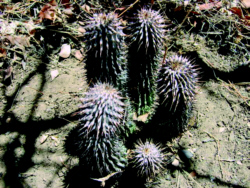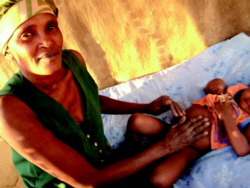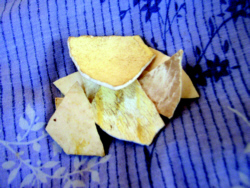Introduction
Local medicine is very common in the Fransfontein area. For a long time
people had to rely on herbal medicine for both minor and major
illnesses. Medicine was derived from trees and bushes. Illness in those
days was often harsh and could sometimes be life threatening.
That’s why our grand-grandparents searched for and discovered
ways to treat these illnesses. They turned to mother nature. They used
the trees themselves, the leaves, called “omazo” in Herero
and “#napogu” in Khoekhoe, roots, called
“omize” in Herero and “!nomagu” in Khoekhoe and
also the bark from the trees (cf. table 6).
| Englisch |
Herero |
Khoekhoe |
| Leaves |
Omazo |
#Napogu |
| Roots |
Omize |
!Nomagu |
| Homeopath |
Omiti vio mbazu |
!Hao-!nâsi /adi-ao |
| Aloe |
Otjindombo |
Au-koreb |
| Sour |
Omaruru |
/Khuru |
| Medicine |
Omuti |
So-/ôa-i |
| Massage |
Okumianga |
!Guri |
Table 1: Plants and treatments in traditional medicine
Use of medical plants in Fransfontein
Here, in Fransfontein, there are traditional healers, referred to as
“onganga yombazu” in Herero and “!hao-!nâsi
/ae-di-ao” in Khoekhoe. Ellie “Eliro” Phillips is
well-known for her traditional approach to medicine in Fransfontein.
People used, and still do use, many types of plants for treating
sicknesses and ailments. However, during this chapter, I will focus
mainly on three, namely the aloe, the devil´s claw and the
fat-plant. Medicine obtained from the these plants is used for first
aid and for treating many acute illnesses.
The Aloe
The aloe plant, called “otjindombo” in otjiHerero and
“au-koreb” in Khoekhoe, is a fat plant, having thick leaves
which are used by the plant to store water during the dry climate. This
is why it is found even during the dry season. The plant’s liquid
is very sour and excellent for sickness treatment. Sour is called
“omaruru” in Herero and “/khuru” in Khoekhoe.

|
Fig 1: Aloe Plant
|
The aloe is used as follows: The leaves of the aloe are cut into small
pieces. A single leaf is enough to make a lot of medicine. They are
then dried in the sun for some days until they become hard. They are
then ground into powder and sifted with a cloth. It is then put in a
small container and stored in a safe place. After this, it is ready to
for use.
Another way of preparing the aloe is in liquid form. The leaves are cut
into pieces and put into a pot or container with water. The pot will be
brought to boil until the water becomes sour. After being boiled, the
water extraction is then taken off and cooled down. After cooling down,
the liquid is sifted and stored in a cool place for later use. The
extraction is the medicine or “omuti” in Herero and
“so-/ôa” in Khoekhoe.
In very serious cases the aloe can also be dropped directly on the
tongue without being cooked or dried. A little water can be drunk
afterwards. This routine can be applied three or four times daily.
However, precautionary measures also have to be adhered in the case of
pregnant women, who should not use this herb, and during the over
indulgence of the aloe as this can result in diarrhea.
| Englisch |
Herero |
Khoekhoe |
| High-blood pressure |
Ombindu ndjironda |
/Gawi-/aob |
| Urinary tract infections |
Omihamo motjene |
//Huru-tsûgu |
| Menstrual problems |
Omitjize vio kukara |
Kharu |
| Low-blood pressure |
Ombindu ndjiheruka |
#Am-/aob |
| STDs |
Omitjize vio rukatuko |
/Goe-ugus !nâ ra hohe //ogu |
| Back-pain |
Omuihamo metambo |
//Â-tsûb |
| Cold-sores |
Ozozurute |
//Khei-/hawis |
| Mouth-ulcers |
Oviruaro mo tjinyo |
Am-!nâs /hawidi |
| Tonsils |
Ozombuize |
/Ôadi |
| Constipation |
Pehuru tjipa kukuta |
Karo-a !nab |
| Intestinal worms |
Omativa pehuri |
!Hobagu/ #nûnigu |
| Stomach pain |
Pehuri tjima pe ihamua |
Tsûa-!nab |
| Skin problems |
Omitjize vio mukova |
!Horas |
| Eye problems |
Okuvera omeho |
Mû-/aeb/ Mû-//ob |
| Hemorrhoids |
Omburu |
Tsui-tsoab |
Table 2: Disease treated with the aloe plant
For all these illnesses, you drink half a glass of aloe water mixture
three times a day, or take in a tea-spoon of aloe powder and drink it
with water. For the skin, you can bathe yourself in aloe-water. For the
eyes, it can be used as an eye-drop. This particular plant is also used
to clean infected blood. Wounds are also washed with aloe water.
Devil’s claw
Called “otjihangatene” in otjiHerero and
“//khuri-//khams” in Khoekhoe, the devil’s claw
usually grows during the rainy season. The plant’s leaves look
like that of a watermelon and, like potatoes, the fruits can be found
underground. The fruits of the “//khuri-//khams” look
exactly like that of the potato, with the only difference being its
sourness. That’s why it is also called the
“wild-potato” among locals. The devil’s claw is used
for much the same diseases as the aloe with the only difference being
that unlike the aloe that is drunk as liquid or powder, the
devil’s claw is chewed.

|
Fig 1: Fat Plant
|
The Fat-Plant
This plant is similar to the aloe, being also a fat-plant and storing
water in its leaves. The fat-plant can be used during the dry season as
well. However, where the aloe has flat leaves, this plant looks much
like a cucumber, growing in one bundle. Unlike the sour taste of the
aloe the fat-plant has a rather good taste. It is called the
“!khopas” in Khoekhoe and is found mostly in mountainous
areas. It has just one root. The “!khopas” Diseases treated
by the fat-plant are blood-pressure problems, both low and high,
back-pain, infected blood, urinary tract infections (kidneys),
menstrual problems and eating disorders. This plant is also eaten as a
snack by many people. San people also use this plant. Currently, I and
another community member are writing a book on the different plants and
their medical use.
From a Traditional Healer’s Perspective: Ellie ‘Eliro’ Phillips

|
Fig 3: Massage
|
Ms. Ellie “Eliro” Phillips was born on 12.12.1964 at
Bloemhof, situated on the road to Bergsig. Her mother is a Nama woman
called Maria and her father a San called Frederick Xhamibeb. Eliro was
raised by her maternal grandmother, Sophia Phillips.
Ellie’s grandmother was a traditional herbalist. She used
different trees and plants, be it their roots, leaves, rhizomes or
bark, to make herbal medicine. She was taught by her grandmother how to
treat young sick babies, how to massage them. She also treats elder
people. In the Fransfontein area, she is well known for her medicines
and treatments. The locals call her “onganga” or
“omupange uombazu” in Herero, and “!hao-!nâsi
/aedi-aos” in Khoekhoe. Eliro usually treats the following
conditions in infants aged 1-5 years (cf. table 8):
| Englisch |
Herero |
Khoekhoe |
| Stomach pain |
Okuihama pehuri |
Tsûa-!nab |
| Diarrhea |
Ombito/ Okupita pehuri |
Xousen-!nab |
| Vomiting |
Ongungo |
/Hûib |
| Vomiting and diarrhea together |
Ongungo no mbito |
/Hûib tsî !nab |
| Intestines |
Okaura |
/Gûis |
Table 3: Different infant illnesses treated by a local traditional healer
| Englisch |
Herero |
Khoekhoe |
| Ostrich-egg shell |
Ei-rombo |
/Amis-!upub |
| Kudu-skin |
Omukova uo horongo |
Xei-khob |
| Garlic |
|
|
| Kidneys of a bak-oor jackal |
Ozozioti zo katakaha |
//Ab-!neira |
| Marijuana |
Omangeha |
Xana-i |
Table 4: Type of infant treatments by a local traditional healer
| Condition |
Substance |
Treatment Mixture |
| Stomach pain |
Ostrich-egg shell, kudu-skin |
The shell is ground to powder, then a very small
piece of the kudu-skin (dried) is cut off, and also ground to powder.
These two substances are then mixed and given (as powder) to the sick
child. |
| Diarrhea |
Same as above |
Same as above |
| Vomiting |
Ostrich-egg shell, kudu-skin and garlic |
The ostrich shell and kudu-skin are prepared as
above, then a clove of garlic is also ground. The kidneys (dried) of a
bak-oor jackal is then ground also to powder. Some leaves (dried) from
a marijuana-plant are also ground, and then all these things are mixed
together, and given to the child three times a day. |
Table 5: Treatment processes of a traditional local healer

|
Fig 4: Ostrich-egg shell
|
Another very popular method used by Ellie is the massage which is
called “!guri” in Khoekhoe and “okumianga” in
otjiHerero. During a massage ritual she usually applies Vaseline,
Vicks, menthol, or balsam kopiva to her hands to lubricate them and
smoothen the massaging. After massaging, the person who has been
massaged is given 4 drops of entress drops, mixed with sugar, which is
drunk with water. For diarrhea, like in any clinic or hospital, she
also mixes 1 liter of water with half a teaspoon of salt and eight
teaspoons of sugar.
Conclusion
During my research on this particular subject I came to realize that
although Fransfontein is a very small village with different ethnic
groups we share the common knowledge of healing each other with herbs
and plants. It also occurred to me that we have many people who
practice traditional medicine in our community and who have a very
broad knowledge of the medicinal qualities of plants. These are future
doctors, who with the right funding could extend this knowledge to
general practitioners and the future generations.



